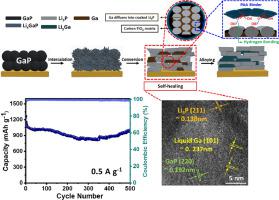Energy Storage Materials ( IF 20.4 ) Pub Date : 2020-11-04 , DOI: 10.1016/j.ensm.2020.11.003 Vo Pham Hoang Huy , Seongjoon So , Il Tae Kim , Jaehyun Hur

|
Self-healing materials have recently received considerable attention for improving the Li storage in anodes with high theoretical capacity that suffer from the mechanical instability triggered by the large volume change that occurs during electrochemical reactions. Ga has recently been explored for self-healing liquid metal electrodes in Li-ion batteries because it can be melted near room temperature. Previous reports have demonstrated the ultra-long cycling stability of these Ga-based electrodes owing to their self-healing properties. Unfortunately, despite these efforts, the performance of these Ga-based self-healing electrodes have not been fully satisfactory, particularly in terms of capacity. More importantly, the self-healing mechanism of liquid Ga has not been clearly investigated. Here, we synthesized GaP as a novel self-healing anode with an ultra-high capacity and stability. Self-healing in this Ga-based alloy occurred via the liquid-solid-liquid transition of Ga during lithiation/delithiation. In addition, by confining the liquid Ga in an appropriate binder (poly(acrylic acid)) through strong hydrogen bonding, stable cyclic behavior of the GaP was achieved. Furthermore, the TiO2-C hybrid matrix promoted the mechanical integrity and electrical conductivity of the GaP (GaP@TiO2-C). Consequently, the GaP@TiO2-C electrode showed superb cyclic performance (1012.0 mAh g−1 at 0.5 A g−1 after 500 cycles) and great rate capability. Various post-mortem analyses, including X-ray diffraction, high-resolution transmission electron microscopy, and X-ray photoelectron spectroscopy, revealed the in-depth electrochemical reaction and self-healing mechanism of the GaP electrode. This study provides insight into the development of self-healing electrodes with high capacities and long cycling stabilities.
中文翻译:

嵌入到高性能锂离子电池混合基质中的自修复磷化镓
自修复材料近来已受到相当大的关注,以改善具有高理论容量的阳极中的Li储存,这受电化学反应期间发生的大体积变化触发的机械不稳定性的影响。由于锂可以在接近室温的温度下熔化,因此最近已研究出Ga可以用于锂离子电池中的自修复液态金属电极。先前的报道已经证明了这些基于Ga的电极的自愈特性使其具有超长的循环稳定性。不幸的是,尽管做出了这些努力,但是这些基于Ga的自愈电极的性能仍不能完全令人满意,特别是在容量方面。更重要的是,液体Ga的自愈机理尚未明确研究。这里,我们将GaP合成为具有超高容量和稳定性的新型自愈阳极。这种Ga基合金的自我修复是通过在锂化/脱锂过程中Ga发生液-固-液转变而发生的。另外,通过通过强氢键将液体Ga限制在适当的粘合剂(聚(丙烯酸))中,获得了GaP的稳定循环行为。此外,TiO2 -C混合基质提高了GaP(GaP @ TiO 2 -C)的机械完整性和导电性。因此,GaP @ TiO 2 -C电极显示出极好的循环性能(500次循环后在0.5 A g -1下为1012.0 mAh g -1)和良好的倍率性能。各种事后分析,包括X射线衍射,高分辨率透射电子显微镜和X射线光电子能谱,揭示了GaP电极的深入电化学反应和自愈机理。这项研究为具有高容量和长循环稳定性的自愈电极的发展提供了见识。



























 京公网安备 11010802027423号
京公网安备 11010802027423号